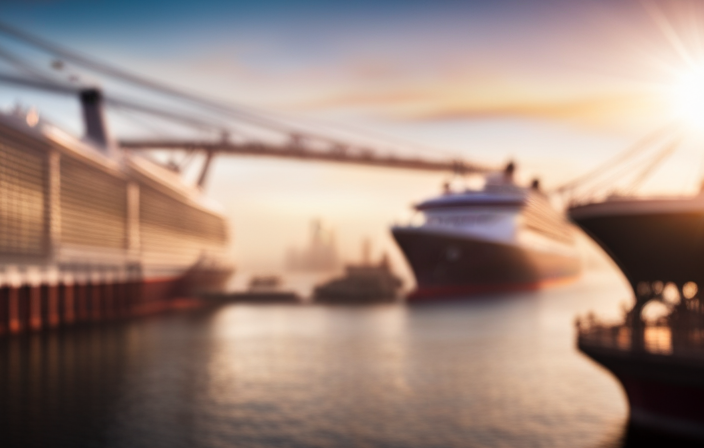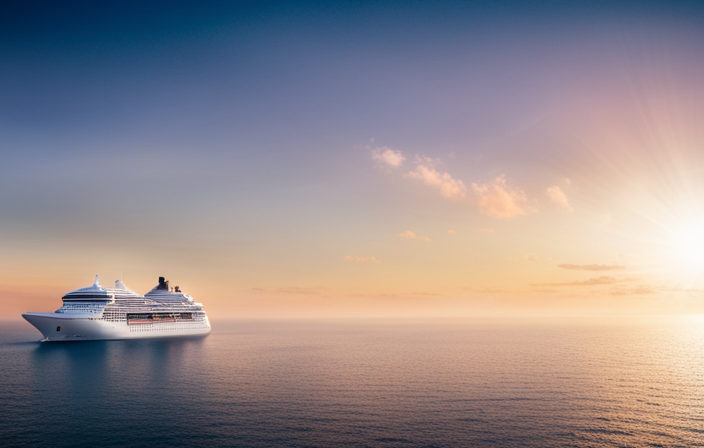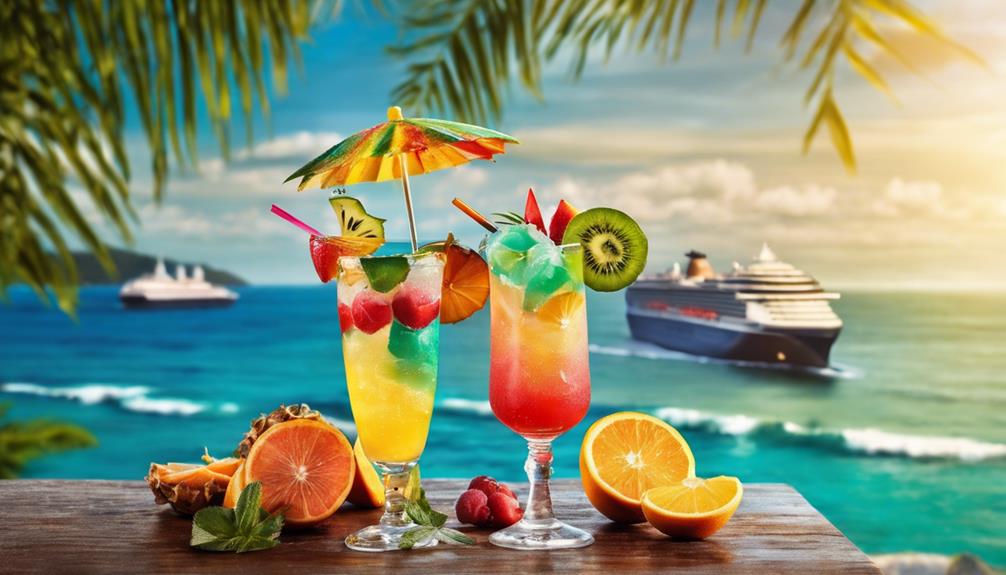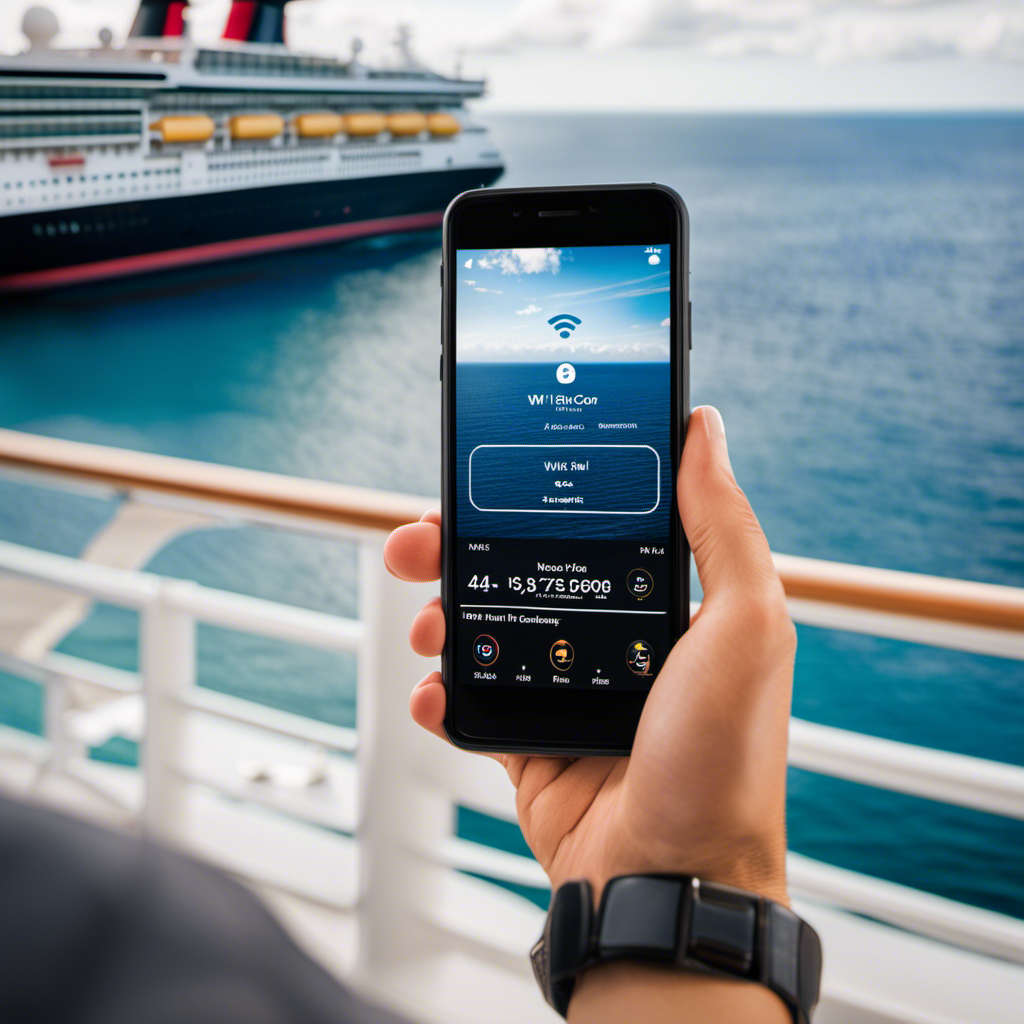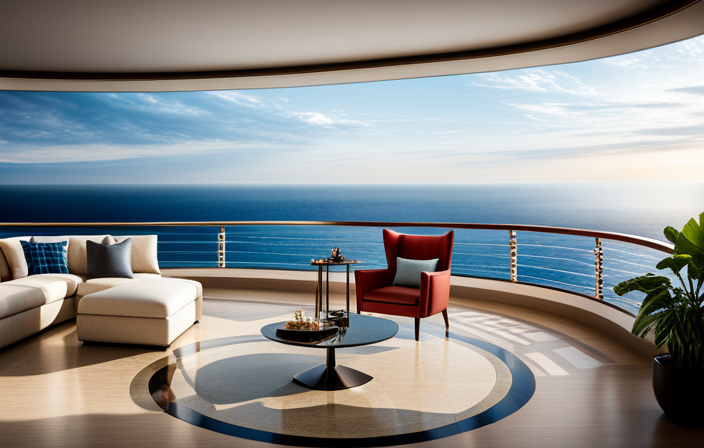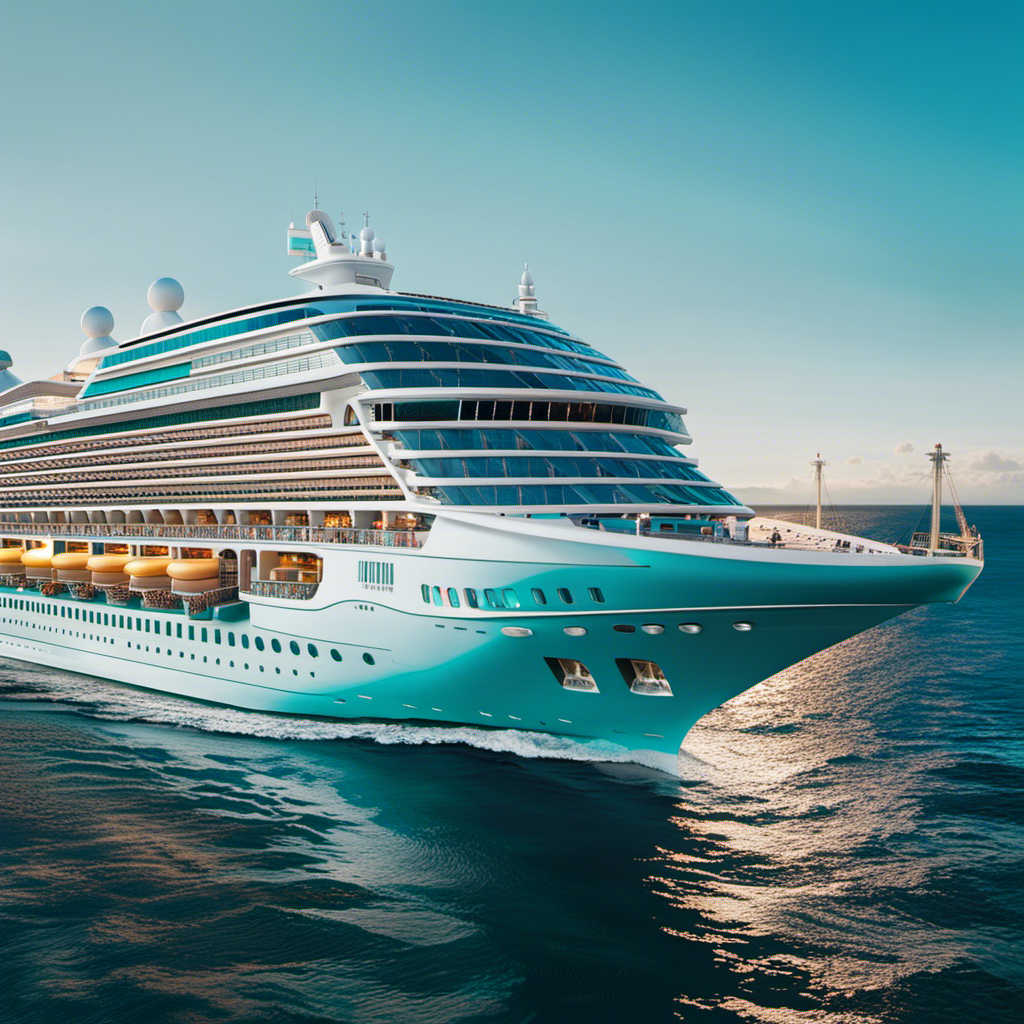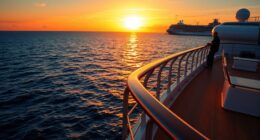Have you ever thought about how those enormous cruise ships are launched into the water? It’s like watching a giant come alive as it smoothly glides into the ocean. In this article, I will give you an insider’s perspective to unravel the complex process of launching these massive vessels.
The construction of a cruise ship begins in dry docks, where naval architects and engineers meticulously plan and design every aspect. Once the construction is complete, the basin is flooded, and the ship’s buoyancy is tested during sea trials. Then comes the moment when the ship is towed to the water, a thrilling sight to behold.
But the journey doesn’t end there. The ship is then fitted out with luxurious amenities, undergoes final inspections and certifications, and embarks on its maiden voyage. And as time goes by, regular maintenance and upgrades ensure the ship remains in top-notch condition.
So, let’s dive into the fascinating world of cruise ship construction and discover how these majestic vessels find their way into the open waters.
Key Takeaways
- Construction process in dry docks involves skilled workers assembling ship sections, the installation of propulsion systems and interior furnishings, and the use of advanced materials and welding techniques.
- Naval architects and engineers play a crucial role in designing the ship’s structure and systems, considering factors like stability, buoyancy, and safety features.
- The ship is launched into the water by flooding the dry dock, utilizing the buoyancy of water to lift and support the ship, and ensuring a smooth and controlled launch.
- After the launch, sea trials and testing are conducted to evaluate the ship’s performance and functionality, and inspections are carried out to ensure compliance with safety regulations.
The Construction Process in Dry Docks
The construction process in dry docks for massive cruise ships is an incredible feat. The ship’s hull is carefully designed and crafted using advanced materials and welding techniques. Skilled workers meticulously assemble the various sections of the ship, fitting them together like a massive jigsaw puzzle.
Once the hull is complete, the ship is transferred to a dry dock. It is carefully floated into place using strategically placed ballast tanks. The dry dock is then flooded, allowing the ship to settle into its natural buoyancy.
Naval architects and engineers take over from there. They oversee the installation of the ship’s propulsion systems, electrical systems, and interior furnishings. With each step, these experts ensure that the ship is not only seaworthy but also luxurious and comfortable for its passengers.
The Role of Naval Architects and Engineers
As a Naval Architect and Engineer, my role is crucial in designing the ship’s structure and systems.
I work closely with a team of experts to ensure that the ship is built to withstand the harsh conditions of the sea and provide a safe and comfortable experience for passengers.
This involves meticulous calculations and analysis to determine the optimal materials and layout for the ship’s hull, propulsion system, and onboard systems.
Safety is our top priority, and we carefully consider factors such as stability, buoyancy, and the implementation of safety features to ensure the ship can navigate any situation safely.
Designing the Ship’s Structure and Systems
When designing the ship’s structure and systems, it is important to consider the forces of the water and prioritize the safety and comfort of passengers. The propulsion system plays a crucial role in providing the necessary power and maneuverability. This involves selecting engines, arranging propellers, and designing fuel and exhaust systems.
The electrical systems design is also essential for powering lights, communication systems, navigation equipment, and other critical components. It requires determining voltage and current requirements, designing distribution and control systems, and implementing redundancy and safety measures.
By carefully designing the ship’s structure and systems, we can ensure that it can withstand the harsh conditions of the water and provide a comfortable and safe experience for passengers.
Moving on to ensuring stability and safety…
Ensuring Stability and Safety
To ensure a safe and stable journey, I prioritize the design and implementation of robust stability measures and safety protocols onboard. Stability is crucial in preventing accidents and ensuring the comfort of passengers and crew. This is achieved through careful calculations of the ship’s center of gravity, buoyancy, and metacentric height.
Stability measures include the installation of stabilizers, which reduce the ship’s rolling motion during rough seas. Safety protocols involve the installation of life-saving equipment such as lifeboats, life rafts, and life jackets, as well as the implementation of emergency response plans and evacuation procedures. Additionally, advanced technologies like stability control systems and watertight compartments further enhance safety.
By meticulously incorporating these stability measures and safety protocols, the ship is prepared to navigate the waters with utmost security.
Moving on to the next phase of the process, let us discuss the crucial step of flooding the basin.
Flooding the Basin
When it comes to launching a cruise ship, creating a controlled environment is crucial. We achieve this by flooding the basin with water.
This allows us to use water to lift and support the ship during the launch process.
Creating a Controlled Environment for Launching
Launching cruise ships involves creating a controlled environment where the ship can smoothly enter the water. Shipyard operations play a crucial role in this process, ensuring that all necessary precautions are taken to ensure a successful launch. One key aspect is the use of a basin, which is flooded to allow the ship to float. To create this controlled environment, a series of steps are followed. First, the basin is carefully prepared, ensuring it is free from any debris or obstacles that may hinder the ship’s movement. Next, the ship is carefully positioned in the basin, using specialized equipment to ensure its stability. Finally, the basin is flooded slowly and steadily, allowing the ship to gradually enter the water. This controlled launch process ensures that the ship is launched smoothly and safely.
Transitioning into the next section, once the ship is in the water, the next step involves using water to lift and support the ship during its journey.
Using Water to Lift and Support the Ship
Once the ship is afloat, the majestic waves cradle and elevate it, providing the necessary support for its journey.
Using water for shipbuilding is an essential aspect of the ship launch process. Water-based ship launch techniques involve carefully utilizing the buoyancy of water to lift and support the massive vessel.
First, the ship is positioned in a dry dock or a specially constructed launching ramp, where it is surrounded by water. The dock or ramp is then flooded, allowing the water to gradually lift the ship off its supports.
As the water level rises, the ship becomes buoyant, and its weight is transferred from the supports to the water. This technique ensures a smooth and controlled launch, minimizing the risk of damage or instability.
With the ship afloat, it is ready for sea trials and testing, where its performance and functionality will be thoroughly examined.
Sea Trials and Testing
During sea trials and testing, my team and I evaluate the performance and functionality of the cruise ship. We meticulously test every aspect, from the propulsion system to the navigation equipment, ensuring that they meet our stringent standards.
Additionally, we meticulously verify that the ship complies with all safety regulations, guaranteeing the utmost safety for passengers and crew.
Evaluating Performance and Functionality
To assess how well cruise ships perform and function, envision the process of getting them into the water as a well-coordinated dance of engineering and maneuvering. Evaluating performance and functionality is crucial to ensuring smooth operation and meeting passenger expectations.
During sea trials, a series of tests measure the ship’s speed, maneuverability, and stability. The propulsion system is evaluated for efficiency and power, while the navigation and communication systems are tested for accuracy and reliability.
The ship’s functionality is assessed through simulations and inspections of onboard facilities. This includes cabins, dining areas, and entertainment venues.
The results of these evaluations provide valuable insights for fine-tuning the ship’s design and ensuring compliance with safety regulations.
Ensuring Compliance with Safety Regulations
After evaluating the performance and functionality of the cruise ship, the next crucial step is ensuring compliance with safety regulations.
This involves conducting thorough inspections to guarantee that the ship meets all necessary safety standards set by regulatory bodies. As the lead engineer, my responsibility is to ensure that every aspect of the ship, from the structural integrity to the emergency systems, adheres to these regulations.
Additionally, we prioritize passenger comfort by implementing measures such as soundproofing cabins and optimizing air conditioning systems. Environmental sustainability is also a key consideration, and we incorporate technologies that reduce fuel consumption and emissions.
To grab the audience’s attention, let me highlight two important aspects:
- Implementing advanced fire suppression systems to ensure passenger safety.
- Designing the ship with energy-efficient lighting and waste management systems to minimize environmental impact.
With safety and sustainability at the forefront, we can now move on to the subsequent section about towing the ship to the water.
Towing the Ship to the Water
Once the ship’s construction is complete, you’ll need to hire tugboats to tow it to the water, a process that can take several hours. Towing techniques and launching mechanisms are carefully employed to ensure a smooth transition from land to water.
To begin the process, the ship is first positioned on a launching platform, which is equipped with a series of rails. Tugboats are then strategically positioned around the ship, attaching strong cables to various points on its structure.
With the help of these tugboats, the ship is gently pulled towards the water, guided by the rails on the launching platform. This method allows for precise control and minimizes any potential damage to the ship during the towing process.
Once the ship reaches the water, it is then ready for the next phase of floating it into its final position.
Floating the Ship
As the ship is gently pulled towards the water, the anticipation builds, knowing that soon it will gracefully float into its final position. Floating a cruise ship involves a precise and technical process known as the launching process. This process utilizes a floating technique that ensures the ship is safely transferred from dry land to the water.
During the launching process, a specialized system is used to gradually lower the ship into the water. This system typically consists of a series of hydraulic jacks that support the ship’s weight as it is being floated. Once the ship is in position, the jacks are slowly released, allowing the ship to rest on the water’s surface.
A table showcasing the steps of the launching process can be seen below:
| Step | Description |
|---|---|
| 1 | Position the ship on the launching platform |
| 2 | Secure the ship to the platform using sturdy cables |
| 3 | Gradually lower the ship into the water using hydraulic jacks |
| 4 | Release the jacks and allow the ship to float |
With the ship now floating, the next step involves fitting out the ship, where the interior spaces are completed and the ship is prepared for its maiden voyage.
Fitting Out the Ship
When fitting out a cruise ship, two key points that require attention are installing interior furnishings and equipment, as well as testing and commissioning systems.
The installation of interior furnishings and equipment involves the careful placement and securing of furniture, fixtures, and amenities throughout the ship’s various spaces and staterooms.
Testing and commissioning systems ensure that all of the ship’s essential systems, such as electrical, plumbing, and HVAC, are functioning properly and can support the needs of the ship and its passengers.
Installing Interior Furnishings and Equipment
To get cruise ships in the water, you can’t help but be amazed at how interior furnishings and equipment are skillfully installed to create the ultimate floating paradise. The installation process involves precise attention to detail and technical expertise. Cabinetry is meticulously fitted into each cabin, providing storage space while seamlessly blending with the overall design. Equipping entertainment areas involves installing state-of-the-art audiovisual systems, ensuring passengers can enjoy a wide range of entertainment options. To evoke an emotional response in the audience, imagine stepping into a luxurious cabin with elegantly crafted furniture, surrounded by panoramic ocean views. The table below highlights the meticulous process of installing interior furnishings and equipment.
| Task | Description |
|---|---|
| Installing Cabinetry | Carefully fitting custom-made cabinetry to maximize space and design |
| Equipping Entertainment Areas | Installing cutting-edge audiovisual systems for passenger enjoyment |
| Ensuring Seamless Integration | Making sure all furnishings and equipment blend harmoniously with the ship’s overall design |
As the interior comes to life, the cruise ship moves closer to its completion. In the next section, we will explore the crucial step of testing and commissioning systems.
Testing and Commissioning Systems
The next step in the cruise ship construction process is ensuring that all systems are thoroughly tested and commissioned. This involves following rigorous testing procedures to ensure that each system is functioning properly and meets all safety regulations.
The ship’s systems, including electrical, mechanical, plumbing, and HVAC, are tested individually and then integrated to ensure seamless operation.
To achieve this, a series of comprehensive tests are conducted, including pressure tests, load tests, and performance tests. These tests involve simulating real-life conditions to verify the reliability and efficiency of the ship’s systems. Any issues or malfunctions discovered during testing are addressed and resolved promptly.
System integration is a critical aspect of the testing and commissioning process. It involves ensuring that all systems work together harmoniously, allowing for optimal functionality and efficiency. This includes testing the interconnectivity of different systems to ensure smooth operation.
Once all systems have been tested and commissioned, the ship moves on to the final inspections and certifications phase.
Final Inspections and Certifications
Once the final inspections and certifications are completed, you’ll be ready to set sail with your cruise ship in the water. The final inspections are a crucial step in ensuring that the ship meets all safety and quality standards.
Highly skilled experts meticulously examine every aspect of the ship, including its structure, machinery, electrical systems, and safety features. They conduct thorough tests to verify that everything is in perfect working order.
Once the inspections are complete, the ship undergoes a rigorous certification process. Certifying agencies carefully review the inspection reports and assess compliance with international regulations and standards. This process guarantees that the ship meets all necessary requirements for passenger safety and environmental protection.
With the certifications in hand, the ship is now prepared for its maiden voyage and inauguration, where it will embark on its exciting journey at sea.
Maiden Voyage and Inauguration
After passing the final inspections and receiving certifications, the cruise ship eagerly sets sail on its maiden voyage, marking the beginning of an extraordinary journey at sea.
The maiden voyage is a crucial event in the life of a cruise ship, as it serves to showcase the vessel’s capabilities and amenities to its first passengers. This inaugural journey is meticulously planned and executed, with every aspect of the ship’s operations closely monitored to ensure a smooth and enjoyable experience for the guests.
From the moment the ship leaves the port, the crew works tirelessly to provide top-notch service, ensuring that all passengers are comfortable and entertained. The maiden voyage is an opportunity for the ship’s staff to demonstrate their skills and professionalism, setting the tone for future voyages.
As the ship embarks on its maiden voyage, plans are already in place for its upcoming maintenance and upgrades to ensure its continued success and customer satisfaction.
Maintenance and Upgrades
After a successful maiden voyage and inauguration, cruise ships enter a phase of continuous maintenance and upgrades. Maintaining a large vessel like a cruise ship presents its own set of challenges.
The constant exposure to saltwater and harsh weather conditions can cause significant wear and tear on the ship’s exterior and interior. To address these challenges, cruise lines employ a team of skilled technicians who perform regular inspections, repairs, and maintenance tasks.
Technological advancements have also played a crucial role in easing the maintenance process. For instance, advanced monitoring systems help identify potential issues before they become major problems. Additionally, innovative materials and coatings are used to protect the ship’s hull from corrosion and increase its lifespan.
These maintenance efforts ensure that cruise ships remain in optimal condition, providing passengers with a safe and enjoyable experience at sea.
Frequently Asked Questions
How long does it typically take to construct a cruise ship in a dry dock?
Typically, it takes around 2-3 years to construct a cruise ship in a dry dock. This construction timeline involves a meticulous process of assembling and outfitting various sections of the ship before it’s ready to set sail.
What qualifications do naval architects and engineers need to have to work on cruise ship construction?
Naval architects and engineers working on cruise ship construction must possess a strong educational background in engineering or architecture, with a focus on ship design and construction. They should also have experience in designing and building large-scale vessels.
How is the basin flooded to allow the ship to float?
To initiate the ship floating mechanism, the basin flooding process is employed. This involves gradually introducing water into the basin, allowing it to rise and support the ship’s weight until it reaches a level where the ship can float.
What kind of tests and trials does a cruise ship undergo before it is ready for passengers?
One interesting statistic to note is that cruise ships undergo over 100 safety tests and trials before they are ready for passengers. These tests include rigorous equipment testing to ensure the highest safety standards are met.
How is the ship towed from the dry dock to the water?
To tow a ship from the dry dock to the water, a launching mechanism is used. This process involves attaching cables or ropes to the ship and using a tugboat or winches to pull it into the water.
Conclusion
In conclusion, the process of getting cruise ships in the water is a meticulous and intricate one.
From the construction process in dry docks, where naval architects and engineers play a crucial role, to the flooding of the basin and sea trials for testing, every step is carefully monitored.
The ship is then towed to the water, where it undergoes fitting out, final inspections, and certifications.
Finally, the ship embarks on its maiden voyage, like a majestic swan gracefully gliding across the water, ready to provide unforgettable experiences to its passengers.
And of course, regular maintenance and upgrades ensure that the ship continues to sail smoothly into the future.

